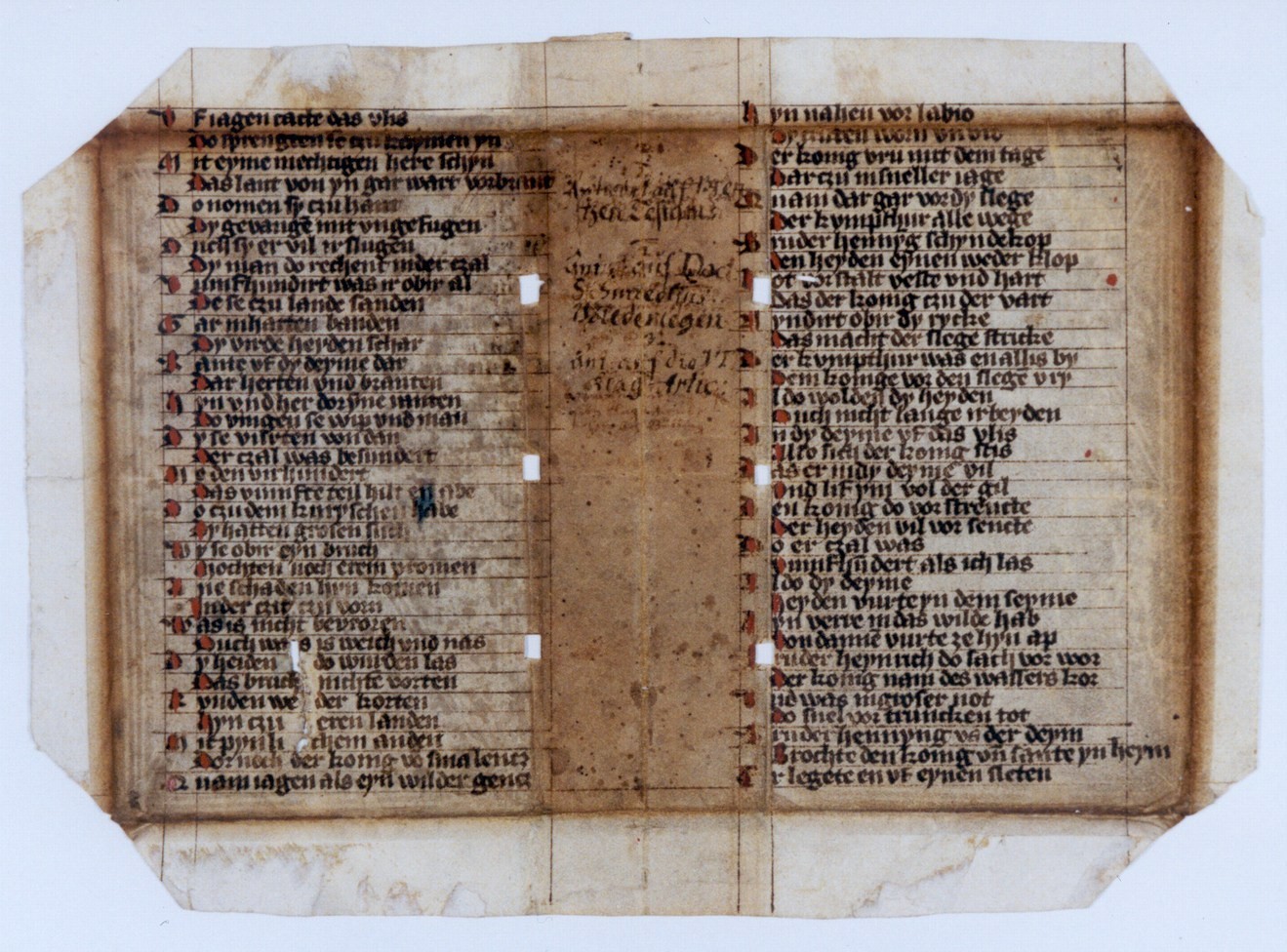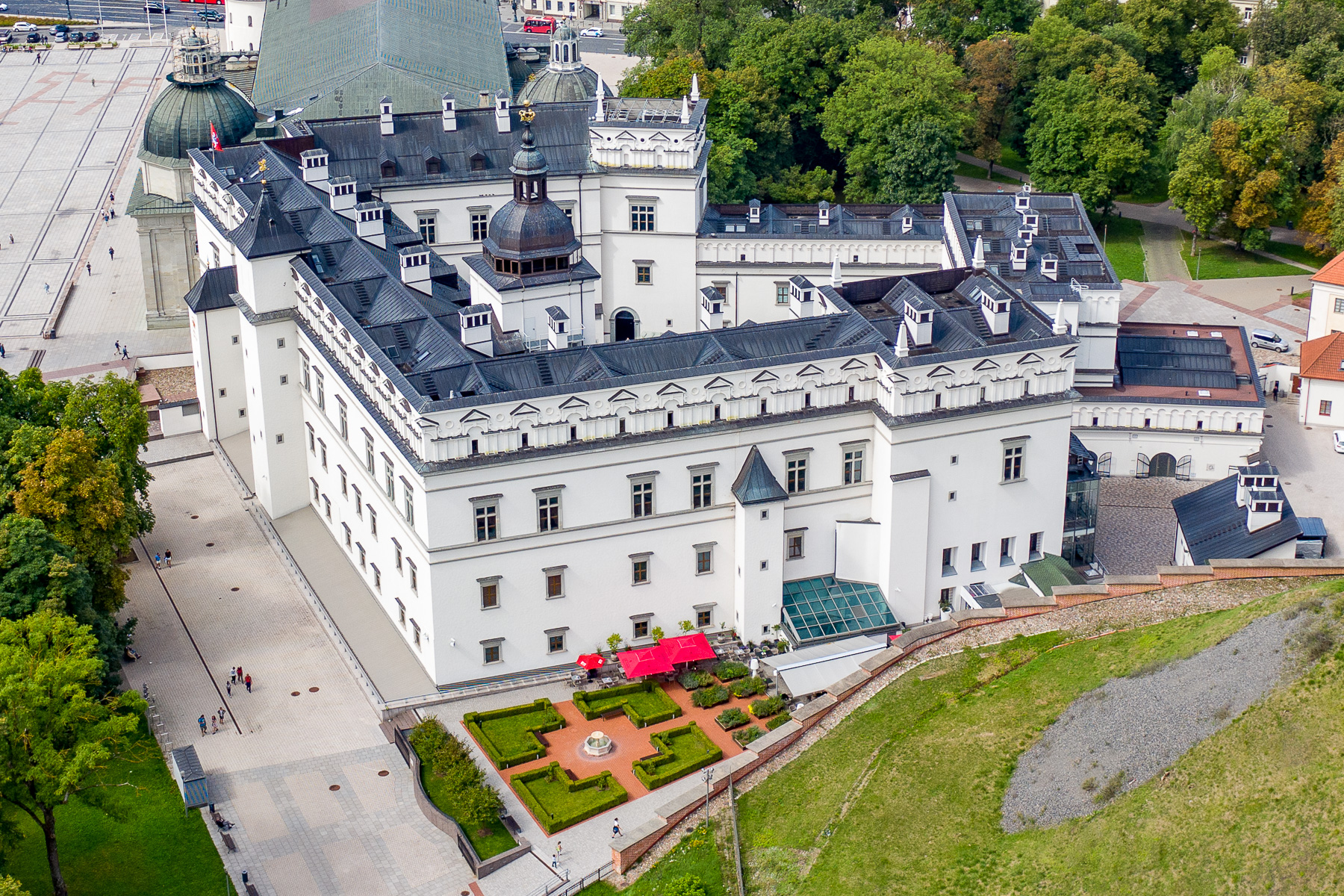|
Tautvilas Kęstutaitis
Tautvilas or Towtwil (c.1352–1355 – September 1390) was one of the sons of Kęstutis, Grand Duke of Lithuania, and a strong supporter of his brother Vytautas the Great in his struggles against their cousin Jogaila. In 1380, Jogaila signed the secret Treaty of Dovydiškės with the Teutonic Knights against Kęstutis. This sparked a civil war. Kęstutis and his son Vytautas was captured and held prisoners in Kreva castle. In 1382 Kęstutis died under suspicious circumstances, while Vytautas managed to escape and sought allies among the Teutonic Knights. Around the same time Jogaila banished Tautvilas from Navahrudak that he and his brother Vaidotas were ruling. Tautvilas then joined the fight of his brother Vytautas. While visiting the Teutonic Knights, he was baptized as Kondrat on October 21, 1383. In 1384 Vytautas and Jogaila reconciled and the civil war ended. When Jogaila signed the Union of Krewo and became the King of Poland, he left his unpopular brother Skirgaila ... [...More Info...] [...Related Items...] OR: [Wikipedia] [Google] [Baidu] |
Kęstutis
Kęstutis ( – 3 or 15 August 1382) was sole Duke of Trakai from 1342 to 1382 and List of Lithuanian monarchs, Grand Duke of Lithuania from 1342 to 1382, together with his brother Algirdas (until 1377), and with his nephew Jogaila (from 1377 to 1381). The Lithuanian name, name "Kęstutis" is a derivative from the old form of the name ''Kęstas'', which is a shortened version of such Lithuanian names as ''Kęstaras'', ''Kęstautas'' (there ''kęs-ti'' means ''to cope''). Historic writing sources reflect different Lithuanian pronunciation. Early life and division of power Kęstutis was the son of the Grand Duke Gediminas. His younger brother, Jaunutis, succeeded his father as Grand Duke of Lithuania. Together with his brother Algirdas, Kestutis conspired to remove Jaunutis from power. They were successful in their efforts. They divided their holdings into an eastern and western sphere of influence. The Duchy of Trakai was established in 1337 as a result. Kęstutis's efforts wer ... [...More Info...] [...Related Items...] OR: [Wikipedia] [Google] [Baidu] |
King Of Poland
Poland was ruled at various times either by dukes and princes (10th to 14th centuries) or by kings (11th to 18th centuries). During the latter period, a tradition of Royal elections in Poland, free election of monarchs made it a uniquely electable position in Europe (16th to 18th centuries). The first Polish ruler whose existence is not debatable was Mieszko I, Duke Mieszko I, who Christianization of Poland, adopted Christianity under the authority of Rome in the year 966. He was succeeded by his son, Bolesław I the Brave, who greatly expanded the boundaries of the Polish state and ruled as the first king in 1025. The following centuries gave rise to the mighty Piast dynasty, consisting of both kings such as Mieszko II Lambert, Przemysł II or Władysław I the Elbow-high and dukes like Bolesław III Wrymouth. The dynasty's rule over Poland ceased with the death of Casimir III the Great in 1370. In the same year, the Capetian House of Anjou became the ruling house with Louis I t ... [...More Info...] [...Related Items...] OR: [Wikipedia] [Google] [Baidu] |
1350s Births
135 may refer to: *135 (number) *AD 135 *135 BC *135 film, better known as 35 mm film, is a format of photographic film used for still photography *135 (New Jersey bus), a New Jersey Transit bus route *135 Hertha, a main-belt asteroid *Škoda 135, a small family car {{numberdis ... [...More Info...] [...Related Items...] OR: [Wikipedia] [Google] [Baidu] |
Vilnius Castle Complex
The Vilnius Castle Complex ( or ) is a group of cultural, and historic structures on the left bank of the Neris River, near its confluence with the Vilnia River, in Vilnius, Lithuania. The buildings, which evolved between the 10th and 18th centuries, were one of Lithuania's major defensive structures. The complex consisted of three castles: the Upper, the Lower, and the Crooked (). The Crooked Castle was burned down by the Teutonic Knights in 1390 and was never rebuilt. The Vilnius Castles were attacked several times by the Teutonic Order after 1390, but they did not succeed in taking the entire complex. Its complete capture occurred for the first time during the 1655 Battle of Vilnius. Soon afterwards, the severely damaged castles lost their importance, and many buildings were abandoned. During the Tsarist annexation, several historic buildings were demolished; many more were damaged during the fortress construction in the 19th century. Today, the remaining Gediminas Tower ... [...More Info...] [...Related Items...] OR: [Wikipedia] [Google] [Baidu] |
Wigand Of Marburg
Wigand of Marburg ()Note that ''von Marburg'' is a purely descriptive title added to his original name of Wigand by later historians, rather than a proper surname. Also the ''von'' should not be confused with a preposition used in later times to denote someone's noble status was a German herald of the Teutonic Knights in Prussia (region), Prussia and one of the notable chroniclers of the Middle Ages. Wigand expanded upon the earlier work of Nikolaus von Jeroschin. His is one of the principal sources of information used for the history of the Prussia (region), Prussian lands and parts of the adjoining Grand Duchy of Lithuania, covering the period between 1293 and 1394. Originally written in Middle High German rhymed prose, the work combined actual accounts with legends, folk tales, and myths. Out of an estimated length of 17,000 lines, only about 500 have survived to the present day. However, in 1464, the Polish people, Polish chronicler Jan Długosz, speaking little German, asked ... [...More Info...] [...Related Items...] OR: [Wikipedia] [Google] [Baidu] |
Vilnius
Vilnius ( , ) is the capital of and List of cities in Lithuania#Cities, largest city in Lithuania and the List of cities in the Baltic states by population, most-populous city in the Baltic states. The city's estimated January 2025 population was 607,667, and the Vilnius urban area (which extends beyond the city limits) has an estimated population of 747,864. Vilnius is notable for the architecture of its Vilnius Old Town, Old Town, considered one of Europe's largest and best-preserved old towns. The city was declared a World Heritage Site, UNESCO World Heritage Site in 1994. The architectural style known as Vilnian Baroque is named after the city, which is farthest to the east among Baroque architecture, Baroque cities and the largest such city north of the Alps. The city was noted for its #Demographics, multicultural population during the Polish–Lithuanian Commonwealth, with contemporary sources comparing it to Babylon. Before World War II and The Holocaust in Lithuania, th ... [...More Info...] [...Related Items...] OR: [Wikipedia] [Google] [Baidu] |
Lithuanian Civil War (1389–1392)
The Lithuanian Civil War of 1389–1392 was the second civil conflict between Jogaila, King of Poland and Grand Duke of Lithuania, and his cousin Vytautas. At issue was control of the Grand Duchy of Lithuania, then the largest state in Europe. Jogaila had been crowned King of Poland in 1386; he installed his brother Skirgaila as ruler of Lithuania. Skirgaila proved unpopular and Vytautas attempted to depose him. When his first attempt to take the capital city of Vilnius failed, Vytautas forged an alliance with the Teutonic Knights, their common enemy – just as both cousins had done during the Lithuanian Civil War between 1381 and 1384. Vytautas and the Knights unsuccessfully besieged Vilnius in 1390. Over the next two years it became clear that neither side could achieve a quick victory, and Jogaila proposed a compromise: Vytautas would become Grand Duke and Jogaila would remain Superior Duke. This proposal was formalized in the Ostrów Agreement of 1392, and Vytautas turned a ... [...More Info...] [...Related Items...] OR: [Wikipedia] [Google] [Baidu] |
Skirgaila
Skirgaila, also known as Ivan/Iwan ( or 1354 – 11 January 1397; baptized 1383/1384 as ''Casimir''), was a regent of the Grand Duchy of Lithuania for his brother Jogaila from 1386 to 1392. He was the son of Algirdas, Grand Duke of Lithuania, and his second wife Uliana of Tver. Biography After Algirdas' death in 1377, Jogaila became the Grand Duke. It is believed that the dynastic disputes that soon erupted between him and his uncle Kęstutis and his cousin Vytautas the Great were largely inspired by Skirgaila. It is known about his travels to the Teutonic Knights in 1379 just a year prior to the controversial Treaty of Dovydiškės. Skirgaila was the chief supporter of his brother Jogaila and helped him to imprison both Kęstutis and Vytautas in Kreva castle during the Lithuanian Civil War (1381–1384). Some historians speculate that Kęstutis' death after a week in prison was in fact assassination carried out by Skirgaila. As a reward for a job well done, Skirgaila r ... [...More Info...] [...Related Items...] OR: [Wikipedia] [Google] [Baidu] |
Union Of Krewo
In a strict sense, the Union of Krewo or Act of Krėva (also spelled Union of Krevo, Act of Kreva; ; ) comprised a set of prenuptial promises made at Kreva Castle on 14 August 1385 by Jogaila, Grand Duke of Lithuania, in regard to his prospective marriage to the underage reigning Queen Jadwiga of Poland. Though very limited in scope, the "Union of Krewo", in historiography, often refers not only to the particular document but to events of 1385–1386 as a whole. After the 1385 negotiations, Jogaila converted to Christianity, married Jadwiga, and was crowned King of Poland in 1386. The union proved a decisive moment in the history of Poland, histories of Poland and history of Lithuania, Lithuania; it marked the beginning of four centuries of shared history of the two polities. By 1569 the Polish–Lithuanian union had developed into a new state, the Polish–Lithuanian Commonwealth, which lasted until the Third Partition of Poland in 1795. Background Situation in Poland Lo ... [...More Info...] [...Related Items...] OR: [Wikipedia] [Google] [Baidu] |
Grand Duke Of Lithuania
This is a list of Lithuanian monarchs who ruled Lithuania from its inception until the fall of the Grand Duchy of Lithuania in 1795. The Lithuanian monarch bore the title of Grand duke, Grand Duke, with the exception of Mindaugas, who was crowned king in 1253. Other Lithuanian rulers, such as Vytautas the Great, also attempted to secure a royal coronation, but these efforts were unsuccessful.Nadveckė, Ineta (6 July 2019Trys Lietuvos karaliai: vienas tikras, vienas nelabai ir vienas beveik''Lithuanian National Radio and Television, LRT''. Until 1569, the Lithuanian monarchy was hereditary. In 1386, Grand Duke Jogaila was elected King of Poland. From that point onward, with some interruptions, the two states were united in a personal union, sharing a common ruler until 1569, when they were formally merged by the Union of Lublin to form the Polish–Lithuanian Commonwealth. The monarch of this new state was elected in a free election by the entire nobility. From the Christianizat ... [...More Info...] [...Related Items...] OR: [Wikipedia] [Google] [Baidu] |
Vaidotas
Vaidotas (fl. 1362) was a son of Kęstutis, Grand Duke of Lithuania. In reliable historical sources he is mentioned only twice: as defender of Kaunas Castle in 1362 and as ruler of Navahrudak. Due to very limited information, his life is subject to wide-ranging theories by historians. Historical mentions According to the chronicles of Wigand of Marburg, he was the commander of the garrison of the newly built Kaunas Castle during the three-week siege in April 1362. After strong resistance the castle was taken over and then destroyed. Vaidotas with 36 men tried to break through, but was taken prisoner. The defeat was one of the largest and important military victories of the Teutonic Knights in the 14th century against Lithuania. In a 1401 document his brother Grand Duke Vytautas wrote that some years before Vaidotas and his brother Tautvilas Kęstutaitis were given to rule Navahrudak equally, but it is unclear when that occurred. Historians proposed 1365 as the most likely ... [...More Info...] [...Related Items...] OR: [Wikipedia] [Google] [Baidu] |




